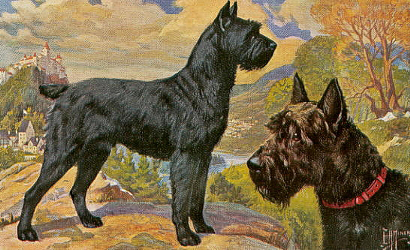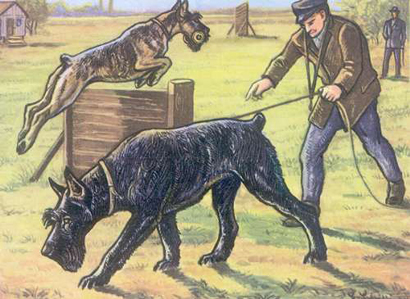Known over history as the Russian Bear Schnauzer, Munich Schnauzer and Riesenschnauzer, the Giant Schnauzer is thought to have come from crosses between dogs such as the black Great Dane, Bouvier des Flandres and the Standard Schnauzer. The word "Schnauze" means "muzzle" or "snout" in German. This word was chosen because the Giants snout and whiskers draw immediate attention. Few races have been more prolific in their development of new breeds of dog than the Germanic peoples. Not only have they evinced rare patience in tracking ancestries, but they have proved their ability to fix type. One of the most notable examples of their breeding skill is the Schnauzer, for there is a dog not only brought to splendid physical conformation and keen mental development, but reproduced in three distinct sizes. The one under consideration here is the Riesenschnauzer – v Giant. It is important to realize that the Miniature, the Standard, and the Giant Schnauzer are three separate and distinct breeds.
 One of the three, the dog now known in America as the Standard Schnauzer, which is the medium-sized specimen, is without doubt the oldest. He is the one apparently portrayed in paintings by Durer, dating from 1492, and he is also the one of the Nachtwachter-Brounnen, the statue of a night watch men and his dog erected in a square in Stuttgart, Wurttemberg, in 1620. These instances are important only as they indicate the antiquity of the type of dog perfected at those dates and still remain today. In unearthing the history of this breed it must be remembered that occupations of men had a great deal to do with all development in dogs. There were no benched shows in those days, and when a new breed was produced, it was aimed at a specific work. Also, its characteristics were governed to large extend to weather and living conditions. All Schnauzers had their origin in the neighboring kingdoms of Wurttemberg and Bavaria. These are agricultural sections where the raising of sheep, cattle, and other livestock has been a major occupation for years. Since railroads were not known, sheep and cattle had to be driven to market, which meant that dogs were necessary to help the shepherds. There is little doubt that when Bavarian cattlemen went to Stuttgart they came across the medium-sized Schnauzer. Here was a dog to catch anyone’s attention, for even then it was sound, while it showed power throughout its trim lines. The Bavarians liked the dog, but they were not satisfied with its size. The sheepmen could use this size of dog, but the drovers needed a larger specimen for cattle.
 The first attempts to produce a drover’s dog on terrier lines, with a wiry coat, were no doubt by crossings between the medium-sized Schnauzer and some of the smooth-coated driving and dairyman’s dogs then in existence. Later there were crossings with the rough-haired sheepdogs, and much later with the black Great Dane. There is also reason to believe that the Giant Schnauzer is closely related to the Bouvier Des Flandres, which was the driving dog of Flanders. The finished product produced an agile deep-chested dog with a huge heart. That's what makes up a true working dog. Once seen, the Giant Schnauzer is seldom forgotten. It's appearance speaks for itself. The Giant has a history as a noble cattle dog and sheep drover. It is a protector that would risk its life for you. The Giant Schnauzer was first used as a cattle driving dog in Bavaria, then later as a guard dog, and by the police and military. The Giant Schnauzer excels at Schutzhund and also makes a good companion. For many years the Giant Schnauzer was called the Munchener, and it was widely known as a great cattle and driving dog. Von Stephanitz places its origin as Swabia – in the south of Bavaria. And it was found in a state of perfection in the region between Munich and Augsburg. When shepherds drove their herds through Bavaria, Giant Schnauzers were soon recognized as guard dogs by shopkeepers. In Germany, the Giant is the dog of choice for police work. Both in Canada and the U.S., Giants are used for rescue work and at airports for detection of illegal and or dangerous substances.
 The Giant Schnauzer was practically unknown outside of Bavaria until nearly the end of the first decade of this century. Cattle-driving was then a thing of the past as the railroad took the cattle to market, but the breed was still found in the hands of butchers, at stockyards, and at breweries. The breweries maintained the dogs as guards, at which duty they were preeminently successful. Not until just before World War I, when their numbers were greatly decreased during the fighting, did the Giant Schnauzer begin to come to nationwide attention in Germany as a suitable subject to receive police training at the schools in Berlin and other principal cities. He proved such an intelligent pupil that police work has been his main occupation since that time. His progress in this capacity in the United States has been very slow. Making his appearance here at the time the German Shepherd was reaching its peak. The Bavarian dog had little chance to make headway against such well-established, direct competition. The first Giants were imported to the United States in the early 1920s and by the 30s, some of the best German breeding stock was in the hands of Americans. Giants were used by the U.S. Army in World War Two. Today, the Giant although rare in the U.S. and Canada, is gaining in popularity.

Description:
Notes:
Personality:
Behavior:
Grooming and Physical Needs:
Talents: |